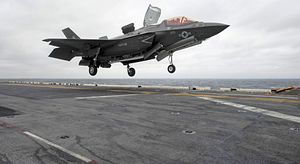A recent report from the Asahi Shimbun confirms what many had surmised; the light carriers Izumo and Kaga may well operate U.S. Marine Corps F-35Bs well before they carry any Japanese versions of the fighter aircraft. The amphibious assault ships will complete their refit as light carriers well ahead of the planned acquisition of F-35Bs, leaving a gap that the Maritime Self-Defense Force will probably use to hone its flight deck operations. The revelation has been mildly controversial in Japan, as it seems to suggest a more subservient relationship with the United States than many are comfortable with.
Notwithstanding the optics, the decision to embark U.S. Marine Corps F-35Bs is almost certainly good news for the future of Japanese naval aviation. It is difficult to overstate the degree to which Japan’s naval aviation program will benefit from cooperation with the United States. It puts Japan way ahead of the China in terms of the long-term development of the arm, regardless of whether the JMSDF decides to expand beyond Izumo and Kaga. In the future, Japan and the United Kingdom may find productive avenues for similar kinds of engagement. It would also not be surprising to see Japan liase with Italy or Spain regarding the use of F-35Bs off the light carriers of those two navies.
By the time Izumo re-enters service, Japan will have been out of the aircraft carrier game for roughly 75 years. Japan will lack trained flight crew, trained maintainers, and procedures for flight deck management and air control. Assuming that cooperation on this point goes forward, Izumo and Kaga will have effectively trained up by the time the first F-35Bs arrive in Japanese service. Moreover, Japanese crews will be familiar with the procedures that USMC aviators have begun to work out for maximizing the capabilities of flat-decked amphibs. The Izumos are of course smaller than the American class light carriers, but extending the training period can only help to increase sortie rates and minimize accidents.
It remains to be seen whether South Korea will benefit from the same kind of cooperation. Currently, U.S.-South Korea relations remain strong, and the fact that South Korea apparently plans to purchase the F-35B to fly from its planned small carrier suggests anticipation of strong cooperation in the future. But the same might have been said of Turkey, which had planned to fly the F-35B from its new carrier TCG Anadolu. Highly visible political problems seem to have scuttled that plan, at least for now. At the moment, it also seems somewhat unlikely that Japan and South Korea could mend fences sufficiently to allow naval aviation cooperation.

































